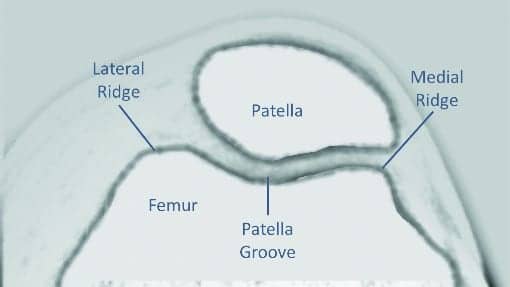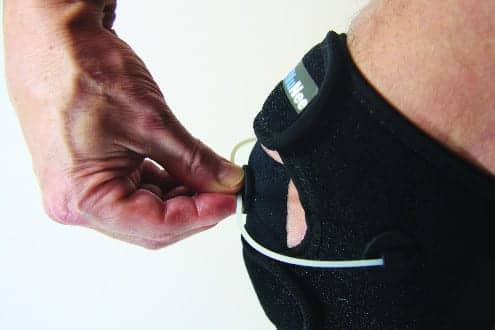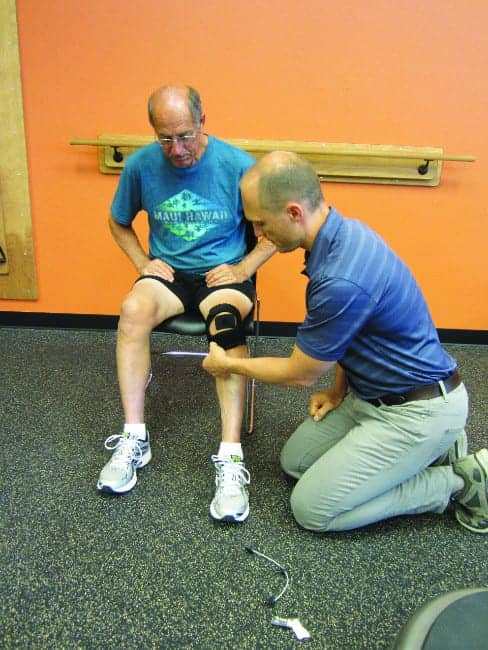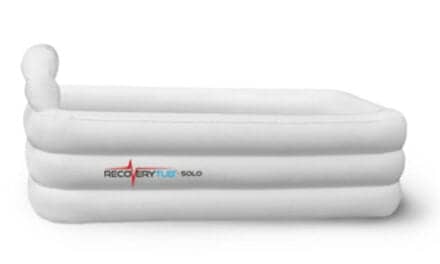By Ben Shatto, PT, DPT, OCS, CSCS
There are many different types of lower extremity injuries that could affect a person throughout his or her lifetime. Common among runners and sports enthusiasts may include knee sprains, patellar tendinitis, and patellofemoral pain syndrome.
Frustrating for Patients and Providers
A knee sprain could affect one or many ligaments. Ligaments that could be affected by a knee sprain include: the medial collateral ligament (MCL); the lateral collateral ligament (LCL); the anterior cruciate ligament (ACL); and the posterior cruciate ligament (PCL). A ligamentous sprain can be from either direct contact or via non-contact injury. Meniscal injuries within the knee are also very common and can be via direct contact or non-contact.
Patellar tendon pain (often called patellar tendinitis or patellar tendinosis) occurs when the tendon connecting the knee cap (patella) to the shinbone becomes inflamed and irritated. Patellar tendinitis is often called “jumper’s knee” because it occurs so frequently in sports like basketball and volleyball. It also affects runners, primarily due to poor lower extremity biomechanics during running, which can lead to an overuse syndrome affecting the patellar tendon.
Patellofemoral pain syndrome (PFPS) is a common diagnosis that is frequently seen by physicians, physical therapists, and athletic trainers alike. Some research states the prevalence and incidence rates as high as 22% of the active population who suffer from PFPS.
Unfortunately, treatment options have not changed much over the last several decades. PFPS remains not only difficult to manage for many patients, but frustrating to providers who have continued poor outcomes in managing such cases.
Source of Pain
From an anatomical prospective, in a healthy knee, the patella glides freely. There is a space (see dark grey in Figure 1) between the patella (knee cap) and the femur (thigh bone) that is filled with synovial fluid, a natural lubricant, that helps to dissipate the pressure exerted on the knee during activities such as running and climbing stairs. That space is vital to the function of a healthy knee joint. The function of the patella is to help translate force from the pull of the quadriceps through the knee onto the lower leg to initiate leg and ultimately, body motion.
Patellofemoral pain often results when the space between the patella and the femur is compromised, causing the patella to no longer glide freely. When this occurs, the patella rubs against the femur and the excessive pressure and irritation leads to inflammation and pain.
Typical treatment options for this condition include: non-steroidal anti-inflammatories (NSAIDs); pain relievers; knee braces; compression sleeves; and physical therapy interventions that typically involve therapeutic exercises to help with patellar motion.
NSAIDs can be useful, as can pain relievers. However, neither medication affect the root cause of the problem, which is a patella that is not tracking appropriately, which causes inappropriate friction between the patellofemoral joint. This is why most cases of PFPS are considered overuse-type injuries since the constant friction from the inappropriate tracking is what causes the pain.
[sidebar float=”right” width=”250″]Product Resources
The following companies provide products for pain management:
Amrex Electrotherapy Equipment
www.amrexusa.com
Ari-Med Pharmaceuticals
www.ari-med.com
Battle Creek Equipment Company
www.battlecreekequipment.com
Dynatronics Corp
www.dynatronics.com
Everyway4all
www.everyway4all.com
LightForce Therapy Lasers by LiteCure LLC
www.litecure.com
Mettler Electronics
www.mettlerelectronics.com
OPTP
www.optp.com
Parker Laboratories
www.parkerlabs.com
PHS Medical by Pivotal Health Solutions
www.phsmedicalsolutions.com
Roscoe Medical/Compass Health Brands
www.roscoemedical.com
Sore No More
www.sorenomore.com
Southwest Technologies
www.elastogel.com[/sidebar]
Measuring Up Modalities for Pain Relief
Electrical modalities such as a transcutaneous electrical nerve stimulation (TENS) has been shown to provide a temporary superficial relief of pain. However, this pain is typically short-lived and does not address the root cause of the pain, which is typically (particularly in PFPS) an overuse problem. As a technology, a TENS unit works to stimulate superficial sensory nerve fibers, which are “faster” than pain fibers. The brain will then recognize the sensory fibers, thus “blocking” some of the pain fiber sensations that cause the person to feel less relative pain. This is known as the pain gate theory.
There are many brands of TENS units on the market. The higher-end models now commonly have other waveforms which makes the portable units more versatile. I commonly recommend two brands for home units given their price point, ease of use, and versatility in having more than one waveform. The Intensity Combo unit has both TENS and Interferential current (IFC) available and can be run off of a battery or plugged directly into a wall. The Chattanooga Primera has the capacity to produce both TENS as well as neuromuscular electro stimulation (NMES) to produce muscle contractions.
There are many other options available within the clinic setting, such as the Dynatronics Solaris Plus, which has the ability to produce multiple waveforms as well as enable the clinician to use ultrasound or light therapy depending on the desired effect.
Other modalities, such as heat or ice, can be helpful for short-term pain relief but do not get to the root cause of the problem. In the case of PFPS, ice is typically the preferred modality because it not only can assist with short-term pain reduction, it also can help with minor swelling (which may be present and worsen the friction syndrome). Another tool that can help therapists manage muscle and joint pain from chronic conditions such as arthritis or address pain symptoms from acute trauma or injury is hot/cold therapy. One source for these types of products is Battle Creek Equipment Company, Fremont, Ind, which offers Thermophore Moist Heat Packs and Ice It! Cold Wraps. The Thermophore product line includes heat packs available in a wide variety of sizes to provide penetrating deep heat. The wraps in the Ice It! product line are reusable, contoured for specific parts of the body, and can remain flexible even when frozen.
The Huntington’s response is where there is an initial vasoconstriction of the blood vessels in close approximation to the cold source that causes the vessels to vasodilate once the cold source is removed. Vasodilation is an opportunity for increased blood flow and, more importantly, increased nutrient delivery to tissue in need of extra nutrients as the body attempts to heal. Therefore, hot and/or cold modalities can be of benefit during the recovery process.
Topical agents can also be helpful for short-term pain relief. However, these agents do not typically address the root cause of the issue. Over-the-counter topical agents may include products that use capsaicin or menthol as the active ingredient. The active ingredients in topicals work similarly to the TENS unit in which sensory fibers are stimulated via a topical “irritant.” The brain feels the irritant on the skin via sensory fibers first, thus “blocking” some of the pain fiber sensations that cause the person to feel less relative pain. This is another example of the pain gate theory.
Most brands also contain a blend of other “inactive” ingredients that are intended to have a longer-duration effect on pain and to reportedly help with healing. For example, a popular topical called Biofreeze, from Cuyahoga Falls, Ohio-headquartered Biofreeze, uses multiple herbs in its formulation, including a popular one found in many topicals called Arnica montana as well as others herbs such as Chamomile and Echinacea.
Exercise Solution
Physical therapy and rehabilitation exercises are typically designed to address the root cause of the issue. This process can address the individual’s weaker muscle groups that may affect proper patellar mobility and function, and may also address other mobility concerns affecting the alignment and movement of the patellofemoral joint such as poor hip, pelvic, and foot mobility. Exercises are commonly prescribed for the lumbopelvic or “core” area, hip abductors, hip external rotators, and the quadriceps.
The problem for many clients and physical therapists working with individuals with PFPS is that rehabilitation exercises may also cause pain due to the irritation and inflammation present in the joint. Not only does this impede the individual’s functional mobility and ability to perform recreational activities, it also impedes his/her ability to perform the prescribed rehabilitation exercises.
Performing any activity that leads to additional pain in the patellofemoral joint is not only demotivating and frustrating but also perpetuates the problem. In my opinion, the pain associated with many of the necessary rehabilitation exercises can prolong treatment results in clients while leading to poor adherence for a prescribed home exercise program. It may also result in more reliance in prescription medications, including opioids.
Bracing as Pain Relief
Bracing for PFPS is nothing new with all the large reputable brands, such as Breg Inc, Carlsbad, Calif, or DJO Global, Dallas, which provides the DonJoy bracing product line, among others, that offer a plethora of options to choose from. Compression sleeves are typically not helpful since they compress the patella further against the femur only to increase the amount of friction between the patellofemoral joint. More advanced braces will incorporate a wraparound solution, which is basically a stay or strap system to attempt to “push” the patella in a different direction. This method can reduce the friction by promoting an improved alignment.
A recent design development in bracing has allowed those experiencing PFPS another option (both short- and long-term) to help them manage this syndrome.

Physical therapist helps a client learn how to engage the NuNee brace. When properly attached, the device should place a gentle outward pull on the kneecap. When properly fitted, it should allow a full range of motion for therapeutic activity.
The NuNee brace from K-Neesio LLC, Rochester, NY, utilizes a proprietary design to help distract (offload) the patella from the femur to allow for decreased friction between the patellofemoral joint. This offloading allows the knee to function more normally with decreased friction and, therefore, decreased pain for the individual. The NuNee’s ability to truly affect the alignment and, ultimately, the amount of friction in the patellofemoral joint is the critical differentiator with this system.
PFPS is associated with poor tracking and friction, which can lead to pain and dysfunction. Incorporating the NuNee has allowed my clients to reduce their pain levels without additional medication management. Among the benefits of this reduction in pain, the client can remain active and reduce their list of activities they have avoided in the past due to their pain. This can have a significant impact on the person’s ability to stay physically healthy and deal with their pain and injury with a positive mind-set.
The NuNee allows the person to participate in a greater array of physical therapy rehabilitation exercises without pain that can limit recovery. In my own experience, incorporating the NuNee brace into my practice has helped to advance a client’s therapeutic exercise program more quickly while getting him or her back to activity faster without risk of continued irritation to the patella, which can prolong recovery.
Sports at all levels, including running and jumping sports that place force onto the lower extremities, are popular in the United States. Over time, repetition of these movements, combined with poor biomechanics, can take a toll on an athlete’s knees, which can sideline them and reduce their activity levels. To return those athletes to the sports they enjoy, physical therapists have many options, and being open to the complete spectrum of products and evaluating their performance objectively can lead to a pain solution that is individualized for each client. PTP
Ben Shatto, PT, DPT, OCS, CSCS, specializes in managing orthopedic conditions. He teaches and guides proactive adults to safely implement proper exercise prescriptions to improve quality of life and prevent or manage chronic disease and illness in order to age well. Shatto’s website, www.thePhysicalTherapyAdvisor.com, provides information and resources to healthcare consumers and clinicians. For more information, contact [email protected].








